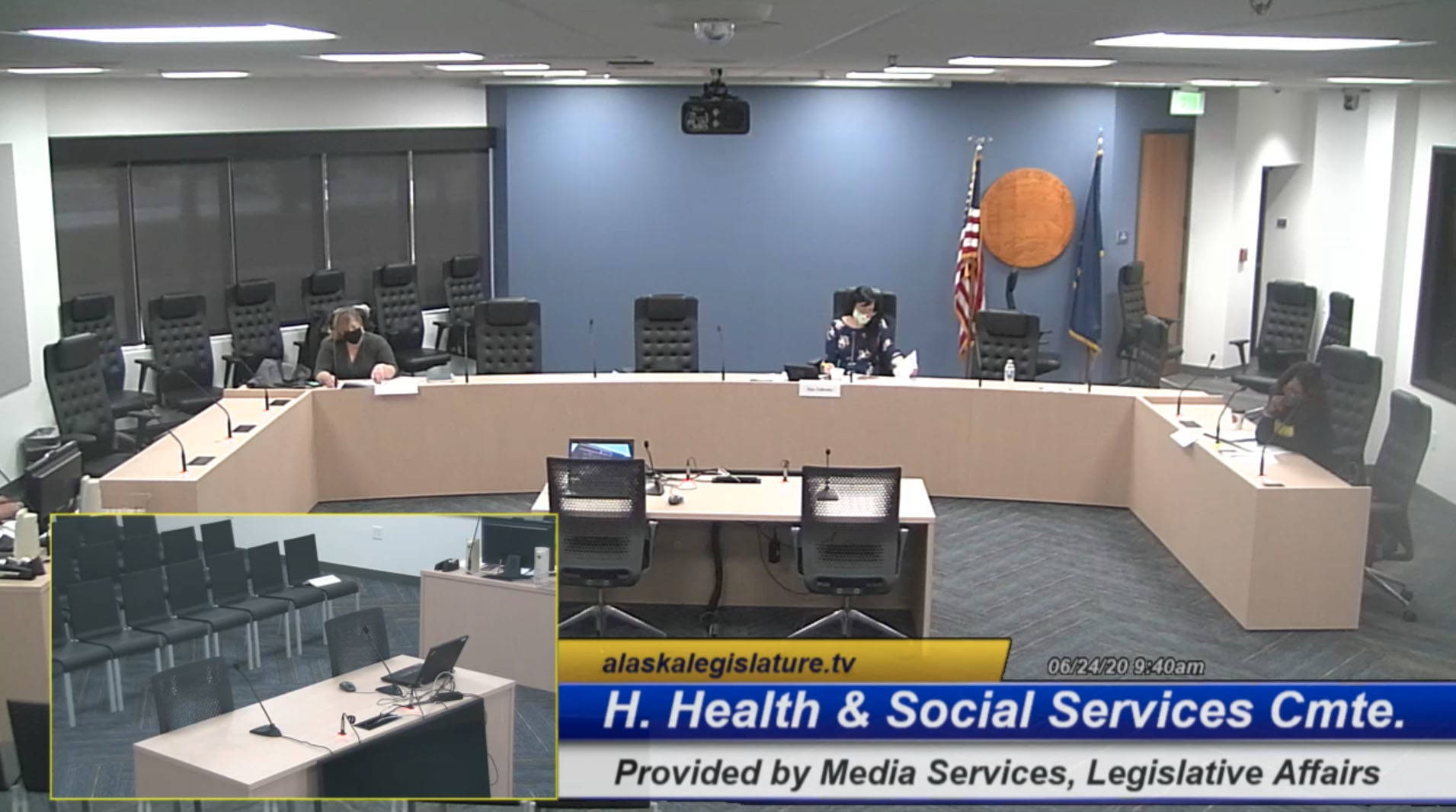Officials with Alaska’s Department of Health and Social Services testified before members of the House Health and Social Services Committee Wednesday on the status of the COVID-19 pandemic.
To mask or not to mask?
During the hearing, several state legislators pressed DHSS Commissioner Adam Crum and Alaska’s Chief Medical Officer Dr. Anne Zink on whether the state will require masks or cloth face coverings in public spaces, given that the state has seen a steady rise in cases ever since steps were taken to reopen Alaska’s economy.
Rep. Tiffany Zulkoski, D-Bethel, asked the question of Crum several times. Crum said that the state is strongly encouraging the wearing of masks, but will not be requiring it. Crum noted that while there has been a rise in cases in the state, the rate of positivity for tests being conducted remains relatively low — .69% as of Wednesday. Individual communities can implement additional restrictions, Crum said, including requiring the use of masks, and the state will assist in those efforts.
Zink acknowledged that recent studies have shown masks to be an effective tool at mitigating the spread of particulates and preventing exponential spread of the virus and said she would like to see more Alaskans wearing masks.
“From a health perspective, my goal is to have as many people wearing masks when they can’t socially distance as possible, using whatever tools we can to get there.”
Zink also said that mandates are more effective at the beginning of a pandemic and would have limited effect if implemented now.
“What we’ve seen previous pandemics and epidemics is that you really get the biggest bang for your buck the first time,” Zink said. “It becomes harder to do the later in to an epidemic or pandemic, so you have to find new or different ways to mitigate the disease.”
Dr. Helen Adams, an emergency medicine physician at Providence Alaska Medical Center, stressed the importance of hand-washing, social distancing and mask-wearing during her testimony, and called on elected officials to promote these practices more aggressively, whether through education, outreach or a mandate.
“I see, personally, that the widespread use of masks in public spaces is the lesser of two evils,” Adams said. “It creates the opportunity for us to continue to go about our business, to participate in our economy, and the alternative is that we could potentially have more sick people, more cost to the state in Medicaid costs, or we’d find ourselves isolating again.”
Risk factors, contact tracing and herd immunity
Beyond the subject of mask-wearing, the state officials were asked about many aspects of the pandemic, from Alaskans’ susceptibility to the disease to the cost of conducting tests and administering a vaccine.
Rep. Matt Claman, D-Anchorage, asked Zink what risk factors may make people more susceptible to severe illness if they were to contract the disease. Zink said that many conditions can be considered risk factors, including obesity, heart and respiratory illnesses. Zink noted that about one-third of Alaskans, or 32%, have one or more risk factors that could exacerbate the disease.
Claman also asked Zink if any data had shown whether gender or ethnicity play a role in the likelihood of contracting the disease. Zink said that there have not been enough cases in the state to make that determination.
Rep. Sharon Jackson, R-Eagle River, asked the public health officials how much the state is paying to process the COVID-19 tests, and how much the state would have to pay for a vaccine once it is developed.
Sana Erfid, assistant commissioner for DHSS, said that while the exact cost has yet to be determined, the state will be relying primarily on FEMA reimbursement funds as well as federal dollars distributed through the Centers for Disease Control and Prevention. State epidemiologist Dr. Joe McLaughlin said that a vaccine will not be developed any time soon, but it is his understanding that the federal government will be paying for the distribution of the vaccine once it is available.
On the subject of vaccines and immunity, McLaughlin noted that much is still unknown regarding people’s ability to develop immunity to COVID-19. The current research available, McLaughlin said, suggests that people who contract the illness may not develop immunity after they have recovered.
Even if a person does develop immunity, it is unclear how long that immunity will last. McLaughlin said that developing an effective “herd immunity” would only come after at least 60 to 70% of the population has become immune to the disease, and even that number is just a guess based on the latest research. Fewer than 800 residents had tested positive as of McLaughlin’s testimony on Wednesday. He said that Alaska has a long way to go before any kind of herd immunity is developed.
“We’ve had 792 cases to date,” McLaughlin said. “Even if this is a tenfold underestimate of the true COVID-19 burden in Alaska thus far, that’s still only about 1% of our population.”
Tari O’Connor, deputy director for the Division of Public Health, spoke about her division’s efforts to build a stronger contact-tracing infrastructure in response to the pandemic. Prior to Alaska’s COVID-19 response, there were approximately 70 people employed with Public Health who performed contact tracing for a variety of illnesses, according to O’Connor’s testimony.
Since the pandemic hit the state, the number of contact tracers has nearly doubled, O’Connor said. Public Health has brought in school nurses from the Anchorage and Kenai Peninsula School District to assist with contract tracing and has also partnered with the University of Alaska system and community health centers across the state to train additional health professionals in contact tracing.
Zulkoski asked if the state was reaching its capacity for contact tracing given the recent rise in cases. O’Connor said that the effort to build more contact-tracing capacity is ongoing, with the ultimate goal of having 500 contact tracers on the job.
The full committee hearing can be viewed at akleg.gov.
Reach reporter Brian Mazurek at bmazurek@peninsulaclarion.com.


